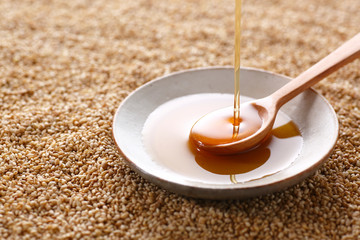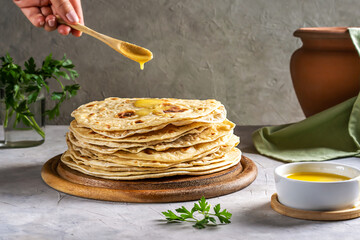
Indian cuisine stands as a testament to culinary excellence, captivating palates with its kaleidoscope of flavors, aromatic spices, and regional specialties. At its core lies an exquisite array of cooking oils, each treasured for its distinct flavor, nutritional richness, and cultural significance. From the tropical allure of coconut oil to the piquant zest of mustard oil, Indian oils serve as the cornerstone of culinary traditions, lending depth and character to traditional dishes. Let’s embark on a culinary odyssey through the enchanting realm of Indian oils, exploring their culinary applications and embracing the essence of Indian cooking.
Coconut Oil

Cultural Significance: Embraced in coastal and tropical regions, coconut oil holds sway in South Indian and coastal cuisines. Its alluring aroma and delicate sweetness make it a perfect companion for curries, stir-fries, and coconut-infused delicacies.
Nutritional Benefits: Laden with medium-chain triglycerides (MCTs) and lauric acid, coconut oil boasts antimicrobial properties, supporting heart health and metabolism.
Culinary Versatility: From the comforting embrace of Avial to the savory depth of fish curry, coconut oil elevates traditional dishes with its rich, tropical essence.
Mustard Oil

Cultural Significance: Revered in North Indian and Bengali kitchens, mustard oil exudes a bold, pungent flavor and distinctive aroma. It finds its place in spice tempering, meat marinades, and vegetable pickles.
Nutritional Bounty: Rich in omega-3 fatty acids and antioxidants, mustard oil is hailed for its cardiovascular benefits and digestive prowess.
Culinary Artistry: From the golden hue of cauliflower to the earthy crunch of okra, mustard oil imparts a golden touch and robust flavor to vegetable delights.
Sesame Oil

Cultural Significance: Esteemed in South Indian, Gujarati, and Maharashtrian cuisines, sesame oil captivates with its nutty essence and high smoke point. It lends its versatility to tempering, frying, and enhancing the taste of myriad dishes.
Nutritional Elixir: Abundant in antioxidants and essential minerals, sesame oil nurtures bone strength, skin vitality, and overall well-being.
Culinary Splendor: From the luscious indulgence of sesame seed chutney to the aromatic allure of til laddoos, sesame oil enriches dishes with its distinctive flavor and aromatic charm.
Ghee (Clarified Butter)

Cultural Significance: Revered as a symbol of purity and auspiciousness, ghee holds a sacred place in Indian culture and cuisine. It graces rituals, festivals, and traditional dishes with its golden hue and velvety texture.
Nutritional Treasure: Packed with fat-soluble vitamins and beneficial acids, ghee offers a plethora of health benefits, from aiding digestion to boosting immunity.
Culinary Opulence: From the comforting warmth of dal to the indulgent richness of biryani, ghee infuses dishes with a luxurious touch and unparalleled flavor.
Sunflower Oil

Cultural Relevance: A staple in Indian households, sunflower oil’s neutral flavor and high smoke point make it ideal for everyday cooking.
Cuisine: Whether frying, sautéing, or baking, sunflower oil adds a touch of versatility to dishes like dals, vegetables, parathas, and salads.
Health Benefits: Rich in monounsaturated fats and vitamin E, sunflower oil supports heart health and may aid in reducing cholesterol levels.
Olive Oil

Cultural Relevance: With its rising popularity, olive oil has found its way into Indian cuisine, particularly in dishes inspired by Mediterranean flavors.
Cuisine: Perfect for drizzling over salads, marinades, and light sautéing, extra virgin olive oil adds a fruity note to dishes.
Health Benefits: Abounding in monounsaturated fats and antioxidants, olive oil offers protection against heart disease and inflammation.
When selecting a cooking oil, consider factors such as cooking methods, flavor profile, nutritional benefits, and cultural context. Experimenting with different oils adds diversity to your culinary repertoire while supporting your health goals. Moderation and balance are key principles to keep in mind when incorporating fats and oils into your diet.
Creating a Balanced Blend for Home Cooking
Combining these oils in your kitchen allows for a harmonious fusion of flavors and nutrients, honoring culinary traditions while embracing wellness. Here’s a recommended blend and quantity for a family of four, based on a daily oil intake of 3 teaspoons per person:
- Olive Oil: 15%
- Coconut Oil: 10%
- Mustard or Sesame Oil: 35%
- Ghee: 15%
- Other Cooking Oils (e.g., Sunflower Oil, Safflower Oil): 25%
Managing Daily Intake
With the recommended daily oil intake set at 3 teaspoons per person per day, let’s calculate the quantity for a family of four. Total oil intake per day for the family: 3 tsp/person * 4 people = 12 teaspoons/day.
Incorporating this blend of different oils into your daily cooking routine allows you to enjoy flavorful, nutritious meals that support your family’s health and well-being, encapsulating the essence of Indian culinary heritage.



